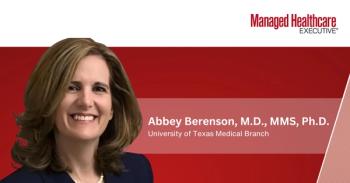
Survey: Healthcare price transparency tools underutilized
Managed Healthcare Executive’s 2017 Technology Survey findings reveal that tools to help consumers estimate the cost of healthcare may be underutilized. Here’s what UnitedHealthcare is doing about that.
Providing healthcare prices to consumers, healthcare professionals and other stakeholders could reduce U.S. healthcare spending by more than $100 billion during the next decade, according to a 2014
HankinsHowever, Managed Healthcare Executive’s 2017 Technology Survey found that 63.4% of the more than 120 respondents do not provide patients with tools to help them estimate the cost of healthcare services.
UnitedHealthcare is one health plan that is committed to providing access to quality and cost transparency resources, “an effort that will help improve the broader healthcare system and empower people to take charge of their health,” says Craig Hankins, vice president of digital products, UnitedHealthcare.
Hankins spoke to Managed Healthcare Executive about what tools they are using to accomplish this, the types of tools being used, and where quality fits in.
Q: When did UnitedHealthcare decide to start using tools to help consumers estimate healthcare costs?
Hankins: UnitedHealthcare has long recognized the importance and need for people to have access to information about the quality and cost of healthcare services. Our commitment to transparency stretches back more than 11 years to when we first introduced the Treatment Cost Estimator (TCE). Since then, we have invested significant time, money and creativity to develop new mobile and online resources that make it simple and easy for people to comparison shop for healthcare based on quality and cost.
The Health4Me app was launched in 2012 and has been downloaded more than 2 million times. UnitedHealthcare is currently revamping our online resource to combine quality and cost information into a singular search function that makes it easier and more convenient for people to access this important information, with early users of the integrated experience more than twice as likely to review cost information compared to users of the stand-alone healthcare provider search feature.
Between our online and mobile resources, the services provided more than $3.8 billion in cost estimates during 2015 to UnitedHealthcare plan participants.
Q: Tell us a little more about the tools are you using. What method has been the most effective?
Hankins: UnitedHealthcare members have access to quality and cost estimates via online and mobile resources. We know more consumers are using digital resources to comparison shop for healthcare. According to a
People can compare costs for more than 875 common medical services across nearly 600 health events, including inpatient and outpatient procedures. Estimates are available to UnitedHealthcare members and to the public through “guest versions” of the Health4Me app and online at
Q: How effective have your cost transparency tools been?
Hankins: A growing number of UnitedHealthcare members are using our transparency resources, with the number and dollar value of estimates growing each year. In addition, people who use UnitedHealthcare’s transparency resources are more likely than nonusers to save money and select high-quality healthcare providers, according to studies from UnitedHealthcare. The resources enabled people to
Q: How does quality fit with these tools?
Hankins: People can use the resources to access quality ratings that are based on the UnitedHealth Premium designation program, which recognizes physicians who meet or exceed quality of care and cost efficiency standards. The program uses more than 300 quality measures for 75 conditions to evaluate physicians.
The UnitedHealth Premium designation program uses national industry, evidence-based and medical specialty society standards to evaluate physicians across 27 specialties to promote access to quality and cost effective healthcare.
- The program bases its methodology on clinical information from physicians’ healthcare claims.
- The program uses criteria and measures based on evidence-based, medical society, and national industry performance measurements from organizations such as the National Quality Forum (NQF), the Ambulatory Quality Alliance (AQA), the National Committee for Quality Assurance (NCQA), and the American College of Cardiology. Practically speaking, evidence-based guidelines are those standards, based on science, which define how a patient should be treated to receive optimal care for his or her condition.
- The cost efficiency standards rely on local market benchmarks for the efficient use of resources in providing care.
In addition, UnitedHealthcare commercial members can also access consumer reviews and information provided by Healthgrades, Hospital Consumer Assessment of Healthcare Providers and Systems (HCAHPS), Leapfrog Hospital Survey, and Leapfrog Safety Scores.
Q: What are the data sources for your transparency initiatives?
Hankins: UnitedHealthcare members access estimates based on actual contracted rates and their real-time account balances, including any applicable deductibles or copayments.
Q: Does this look only at physician? Facility?
Hankins: Both. Estimates are displayed as “care bundles,” providing a comprehensive view of what people should expect throughout their course of treatment for nearly 600 health events.
Tracey Walker is content manager for Managed Healthcare Executive.
Newsletter
Get the latest industry news, event updates, and more from Managed healthcare Executive.



















































